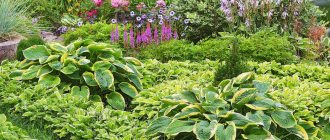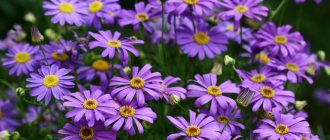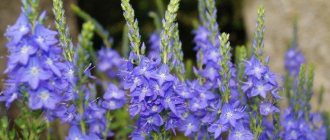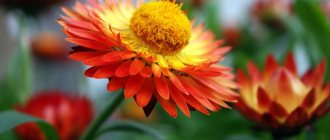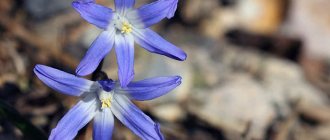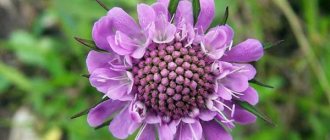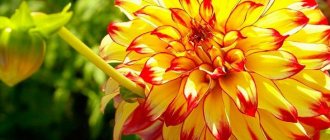Alyssum is a genus that includes more than 100 varieties of various plants, of which only a few have found recognition in the eyes of gardeners and are often found in gardens. Alyssum (Alyssum, Lobularia) belongs to the family of cruciferous plants - Brassicaceae.
The small, abundantly flowering alyssum is one of the least demanding ornamental plants. In the article we will look at and learn the main advantages of alyssum, features of planting and care, photos of popular species and varieties.
Short description
In spring, rocky garden beds will be pleased with golden-yellow flowers; from summer to autumn, we will be delighted by sea alyssum with white, pink or purple flowers. The flowers are small but numerous, located on one stem, collected in so-called clusters. Shoots with flowers reach a length of 30 cm, growing from a rosette of oblong leaves of grayish-green color.
A luxurious favorite of honey bees - alyssum
Alyssum or alyssum (Alyssum) is a bright representative of the Cabbage family, growing in Asia, Europe and North America.
The genus includes more than 100 species of herbaceous plants, among which there are both annuals and perennials.
Thanks to its amazing unpretentiousness and long, abundant flowering, alyssum is much loved by gardeners.
Its small flowers are collected in small tassels, from which a pleasant honey aroma spreads throughout the garden. This is another advantage of alissum. Bees and other insects actively flock to its smell, pollinating the rest of the plants in the garden along the way.
Blooming alyssum is a continuous carpet of bushes up to 40 cm high, strewn with small delicate clouds of white, pink, yellow, red and purple shades. And all this splendor pleases the eye from the beginning of spring until late autumn.
This flowering plant fits perfectly into any landscape. It is planted in ridges, flower beds, mixed flower beds and street flowerpots. Alyssum can grow even in soil-filled voids in masonry. Due to its ability to take root between stones, the plant has another name - “stone stone”.
Popular types of alyssum
Below are popular types of lobularia with photos.
Silver (Alyssum argenteum)
A perennial, reaching approximately several tens of centimeters in height, its natural habitat is the European continent. It is distinguished by decorative yellow inflorescences and long, lanceolate silver-gray-green leaves.
Borage alyssum (Alyssum alyssoides)
Perennial plant, 30 cm high, with low requirements. Natural habitats - Southern Europe, Caucasus. Grows in roadside ditches and thickets. The flowers are yellow, the leaves are lanceolate, gray, shaggy.
Rocky (Alyssum saxatile)
Grown in gardens, a variety with high decorative qualities. Few requirements for habitat. In April it becomes covered in thousands of yellow flowers, creating interesting cushions of sunshine that contrast well with other flowers, such as purple phlox. Native to mountainous regions of Europe and Asia. Shrub with woody shoots. Flowers are collected in a panicle. The leaves are lanceolate, gray-green. The bush reaches a height of 30 cm. After flowering, if the plant does not need to produce seeds, we cut off the flowers and wait for flowering again.
The perennial rock species grow well, producing yellow fields of flowers when in bloom. When the inflorescences turn red, it is worth cutting off the stems. Then the leaves covered with silver hair become a decoration; flowers may appear again in early autumn.
Mountain Alyssum (Alyssum montanum)
A perennial characteristic of the European landscape. It takes on a creeping form, the bushes reach a height of 20 cm. Yellow flowers are collected in clusters. The leaves are gray-green, lanceolate. It is considered a long-lived plant.
Marine lobularia - marine alyssum (Alyssum maritimum, Lobularia maritima)
An annual plant with very varied uses. Planted in the garden, in boxes, pots on the balcony, terrace. Forms compact, very branched, flowering bushes. Blooms profusely in summer in colors - white, yellow, pink, purple. After pruning it blooms again, so you can extend the flowering period. Reaches a height of 20-30 cm, characterized by bright flowers collected in clusters. The leaves are lanceolate, covered with hairs.
Sea varieties have a very pleasant, slightly sweet aroma of honey. Most often they are white, but are also found in shades:
- pink;
- purple;
- dark burgundy.
There are varieties with leaves bleached white or creamy.
Ampel varieties of alyssum
During the season, the plant grows, the stems droop, and the alyssum takes on a drooping shape.
Ampelous alyssum, photo
The marine species includes a whole group of varieties with the collective name ampelous. These varieties look great in the garden, on the balcony, on the terrace. The name ampelous is associated with the shape of the plant, which has characteristic, slightly drooping, twisting shoots, covered with beautiful flowers during the flowering of alyssum. Proper pruning of hanging varieties will help create an interesting sphere that looks beautiful when let loose.
Flowers work great on verandas and in hanging pots. In the garden, they can be planted on top of stones so that the shoots fall well. Ampelous alyssum stands out in every garden and is very popular.
The most common types of garden borers are:
- mountain;
- nautical;
- rocky;
- silver.
Caring for alyssum at home
Protecting alyssums from waterlogging with fairly frequent watering is the main difficulty that can be encountered in growing alyssums in a new format. They are very sensitive to both a lack of nutrients and excessive feeding, and react extremely poorly to the lack of pruning and sanitary cleaning.
Alyssums can be recommended to those who like to constantly “communicate” with plants and surround them with care. It is better to grow them as an indoor crop only if you have experience transferring them into the rooms of other summer growers.
Watering and air humidity
Alyssums in potted format require even more careful watering than garden ones. They fully inherit their drought resistance and will not suffer if the substrate dries out completely for a short time. But they are vulnerable to waterlogging and dampness. Too much, frequent watering and stagnation of water lead to the death of the plant.
When watering alyssums, you should let the substrate dry at least halfway. During flowering, you can change watering by drying the soil in the top layer. It is better not to allow the water to stagnate in the pan. Drought shortens flowering time. But the sluggish appearance of the shoots should not be scary: usually, after watering, the plant quickly restores turgor.
Alyssums actively use moisture reserves in summer and may require daily watering. The degree of drying of the substrate should be checked more often.
During the dormant period, if alyssums are kept as perennial plants, watering is slowly reduced, allowing the substrate to dry almost completely and focusing on the temperature of the content.
For indoor alyssum, only boiled, melted, rain or filtered water is suitable.
Watering for alyssum must be done very carefully. Wetting greenery and shoots indoors will quickly lead to the loss of the plants' decorative properties.
Air humidity is not important for alyssums. But not if they are kept in the heat. In the summer months, you need to take care of additional water procedures, compensating for uncomfortable temperatures with foggy spraying, installing trays and containers with moistened decorative materials. In autumn, winter and early spring, any moisturizing measures should not be carried out.
Top dressing and fertilizer composition
Despite its abundant flowering and dependence on the quality of the soil, indoor alyssum does not like too active fertilizing. For this purpose, fertilizers are applied in liquid form, along with water for irrigation, in half the concentration compared to the manufacturer’s recommendations.
The optimal frequency of feeding is once every 3 or 4 weeks. More active fertilizing can be carried out at the beginning of flowering, more rare - before it begins and from the second half of summer.
Alyssums are fertilized only from the beginning of active growth until the end of flowering.
Universal complete mineral fertilizers are suitable for alyssum. In indoor conditions, organic fertilizers will only benefit the plant. But it is worth choosing high-quality preparations with controlled characteristics from among biofertilizers and humus mixtures. During the flowering period, the composition of fertilizers can be changed by starting to use fertilizers for beautifully flowering crops.
Indoor alyssum looks inimitable in its hanging form. © Limundo
Pruning and shaping alyssum
Alyssums look better the more regularly the fading inflorescences are removed. After all, a sloppy appearance with the effect of a continuous covering of flowers with lace spoils the overall impression too much.
Pinching the tips of the shoots at an early stage of development allows you to speed up the thickening and growth of the plant. Alyssum can be trimmed several times over the summer, especially if indoor plants bloom less profusely. They not only recover well, but also bloom again quite quickly.
The standard pruning level for this indoor plant is considered to be 1/3 of the height. Removing damaged or drying shoots and dry leaves allows you to keep the bushes neat. And the removal of the lateral, most spreading shoots along the perimeter of the bush stimulates more luxuriant flowering of the main mass of branches on the bushes.
If alyssums are saved for the winter, the bushes are pruned more heavily in early spring, after replanting, leaving short stumps or 1/3 of the height to stimulate their renewal.
Transplantation, containers and substrate
The need for replanting of alyssum directly depends on the quality in which they are grown. If alyssums are kept as perennials, then the plants are replanted at the first signs of growth in the spring, carefully transferring them to new containers after pruning.
If the plants are saved for spring cuttings or will be replaced with new bushes, considered as a summer plant, then there is no need for replanting and it is enough to follow the rules when planting seedlings and rooted cuttings in permanent containers. One of the peculiarities of alyssums is that they tolerate replanting well even when flowering, but only if they are carefully handled.
This garden and indoor plant is completely undemanding to the soil. It is enough to choose a universal, water- and breathable substrate, consisting of several components and necessarily including turf soil and sand.
Alyssums love perlite, vermiculite and other loosening additives, which are best added to any, even the highest quality, substrate. The optimal pH value for alyssum is from 5.5 to 6.5.
Alyssums can be grown in automatic watering systems or with the addition of hydrogel to create stable humidity. They are not very suitable for hydroponics. But otherwise they demonstrate amazing adaptability to alternative growing methods.
Alyssums are not very fond of deep containers, preferring to grow in well-drained containers that are wider than they are tall. A very high layer of drainage is laid at the bottom of the containers, mainly made of pebbles, shards, crushed stone or large expanded clay.
When transplanting alyssums, it is important to ensure that the same level of deepening is maintained. The plant does not like shoots being buried and can quickly die from rot if watered inaccurately. It is advisable not to destroy the earthen ball when transplanting and keep it intact. Otherwise, there are no tricks to planting a plant. It is enough to take care of high-quality watering and maintenance in “average” conditions after planting and replanting.
Alyssum is one of the easiest plants to propagate. © shumiao
Alyssum flowers - decorative qualities
Perennial and annual alyssum deserve attention; they are characterized by abundant flowering and low cultivation requirements. The most common varieties in our gardens begin to bloom in April - rock and mountain alyssum. In May, the rocky species ends flowering; in June, the mountain species ends, but the silver and sea species begin to bloom. Silver blooms until August, sea, depending on the sowing date, until autumn. Flowering in autumn replicates the mountain look.
All mentioned species, except the marine one, are perennial plants. Sea alyssum is an annual plant.
Choosing a place and soil for planting
How to choose a place to plant alyssum?
For alissum, choose open and sunny areas. You can plant them in the shade, but with this planting the flowering will be worse.
The soil should be dry, loose and permeable. With poor drainage, plants are more often affected by fungal diseases.
If the soils are heavy and clayey, then compost, humus, and sand are added to them. If necessary, lime the soil to reduce acidity. Its level should be neutral or alkaline, since in nature alyssum prefers calcareous sandy soils.
The plant is undemanding to fertility. Lobularia can grow even on poor soils. The main thing is that plants should not be grown in soil fertilized with fresh manure.
Popular varieties of alyssum
| Species name | Variety name, photo | Description |
| Nautical | "Violet Queen" "Violet Queen" | Alyssum with small flowers in shades of purple and lilac. |
| Nautical | "Royal Carpet" | The variety reaches a height of 20 cm, with purple-white flowers. |
| Rocky | "Plenum" | A very valuable variety due to its full flowers. |
| Nautical | "Snow Carpet" | Alyssum is an annual white plant characterized by white flowers. |
| Nautical | "Rosie O'Day" | A variety with flowers in shades of red and pink. |
| Rocky | "Compactum" | A variety that blooms richly with golden yellow flowers and is compact. |
| Rocky | "Citrinum" | A variety that blooms with lemon flowers. |
| Rocky | "Gold placer" | A ground cover variety of alyssum with yellow, small flowers. |
| Rocky | "Golden Wave" | Alyssum is spreading, low growing, blooming profusely. |
| Rocky | "Big Jam" | Alyssum with large flowers of purple, lilac, white. |
| Nautical | "Oriental Night" | Variety with dark purple flowers |
| Nautical | "Snow Queen" | Multiple winner of many exhibitions. Cold-resistant annual, blooms with small flowers in various shades: pink, red, white, yellow, purple. Compact, spreads beautifully, blooms profusely throughout the season. Recommended for balconies, tall pots, hanging baskets. Planted in the ground it will produce a carpet of flowers. |
Perennial and annual alyssums
The plant can be either perennial or one-year-old. It would seem that the former are preferable for garden beds. However, many gardeners choose annuals for their special honey aroma and snow-white color. Perennial alyssums are most often yellow in color, they bloom a little less luxuriantly and do not have such a sweet, intoxicating aroma.
This is interesting! The name Alyssum (Latin) translates as “no dog rabies.” Indeed, in ancient times, a certain variety of this plant was used by healers against rabies.
Growing and care
Lobularia does not belong to the demanding ornamental plants. She prefers sunny or slightly shaded positions. Garden flowers of perennial alyssum are completely resistant to frost; the marine species is considered an annual plant.
Soil requirements
Alyssum soil requirements:
- permeable;
- light;
- preferably drained;
- alkaline or neutral.
Rocky species are completely frost-resistant and have no special soil requirements, although it is better to choose permeable and even rocky soil. Clay soil is also suitable. Rocky varieties are accustomed to infertile, rocky soils, so they do not need fertilizers, but they do need liming of the substrate.
Where to plant rock species?
Sea and rock varieties are united by a passion for the sun; sea varieties are somewhat more demanding in cultivation.
Rocky varieties can be planted in flowerbeds; they also grow well on stones, to which the flower is especially suitable, due to its origin. They can also be used to line stone walls. It is worth using the preference of a plant that grows best in dry and sunny places - few flowers can withstand such conditions, especially without additional care.
Watering, fertilizers and stimulants
Watering and fertilizing alyssum is carried out depending on needs. Rock alyssum does not need to be irrigated. If the summer is sunny and dry, the flowers will bloom again in September.
Attention! Alyssums, especially rocky ones, do not tolerate waterlogging of the soil. It is necessary to ensure that stagnation of water does not form, otherwise this can lead to root rot.
After flowering and cutting the plants, it is worth watering them with a liquid multi-component fertilizer for flowering plants to stimulate re-blooming.
Pests and diseases
Alyssum is not very vulnerable to diseases and pests. Among insects, the cruciferous flea beetle can cause problems - a small insect 2-3 mm in size, feeds on leaves, and on hot days can destroy seedlings in 3-4 days.
Ways to fight:
- agrotechnical - weeding of weeds that serve as food for flea beetles;
- early sowing dates in cloudy weather;
- chemical - used when 10% of the bushes are affected - spraying with insecticides: karate 5%, zolon 35% or modern analogues.
During rainy periods or with excessive watering, the roots of alyssum are affected by root rot, and the leaves are covered with a white-gray coating - powdery mildew. Root rot is manifested externally on the plant by yellowing of the leaves. Sick plants are dug up, then the rhizome is washed with a weak solution of potassium permanganate, and be sure to be transplanted to another bed. For powdery mildew, you can treat the leaf with a fungicide solution - topaz 10%, caratan 18%.
Trimming
Sometimes alyssium stops flowering. It happens that sea varieties stop blooming. Then you need to cut off the stems with faded flowers - after about 2-3 weeks the flowers should bloom again. The sea varieties have a delicate appearance, accustomed to warmer climates because they come from regions near the Mediterranean, but are surprisingly resistant to autumn cold. If there were no severe frosts, flowering would take place even until mid-December (in balcony pots).
How to collect seeds?
If you plan to collect seeds, you do not need to remove the inflorescences in order for the seed pods to fully ripen. Collection begins at the end of September or beginning of October. To do this, select large, but already dried flowers, which are carefully rubbed in your hands. There will be a lot of large debris that needs to be carefully removed.
After this, the collected seed material is placed in a warm and well-ventilated place to dry. The finished seeds are poured into a fabric bag and stored in a dry and fairly warm room for no more than 3 years.
The timing of seed collection is individual for each case. It is necessary to ensure that they do not fall off before they are collected.
In the event of a possible attack on Alyssum by pests or diseases, you can use standard products intended for any garden crops.
Reproduction
Perennial species can reproduce in several ways:
- seed propagation method;
- layering;
- dividing the bush;
- seedlings (saplings).
In the case of rock species, separation of plants, especially old ones, is at risk.
Propagation of alyssum - growing from seedlings
Marine alyssum (annual) is sown in open ground from April to May in a permanent place directly into the ground. You can prepare seedlings in containers in advance. It is better to sow alyssum in rows with a distance of 15-20 cm. After planting the seeds for seedlings, seedlings appear that need to be thinned out, leaving plants every 5 centimeters. The seeds germinate in about a week. Flowers bloom approximately 2 months after sowing.
It is important to know when to collect alyssum seeds. Seeds are collected at the end of September after flowering. The inflorescences are rubbed between your fingers, separating the seeds, and dried thoroughly.
Method of planting by layering and cuttings
More often, alyssums are propagated by layering, which should be stored in a warm place in water. If they send out roots, they need a lot of air and aeration. This method is quite labor-intensive and does not always work.
Rock and mountain varieties are propagated by cuttings made from semi-lignified shoots (they are taken in August and after rooting in September, they are planted).
Propagation by seedlings
Seedlings and even flowering alyssums can be purchased at most garden centers. They are sold primarily in May, but can be found throughout most of the season. Seedlings are planted in groups of 2-3 plants at a distance of 30 cm, which gives 11 plants per 1 square meter. The space between them can fill up quickly because the bushes spread quickly.
Perennial alyssums can be sown directly into the ground, but propagation from cuttings makes it easier to develop a design.
When to plant alyssum for seedlings
More than half of flower growers prefer the seedling method of growing Alyssum. With this method, you can be guaranteed to plant the required area without fear that some seeds will not germinate and bald spots will form among the plantings.
Since Alyssum is quite cold-resistant, its seedlings can be planted in late spring. Thus, seeds are sown to obtain seedlings at the end of March, but flower growers still sow from mid-April.
The flower grows quickly, developed bushes are ready for planting within a month. But, nevertheless, when preparing for sowing, two factors should be taken into account: growing conditions and climatic features of the region.
In the northern regions, you should not prepare seedlings too early, as by the time of planting they will have outgrown and may become very sick. For pot growing, the time of sowing does not matter. One more important nuance should be taken into account - lighting.
Lack of light will lead to the stretching of Alyssum seedlings, it will be frail and painful. For early plantings, it is necessary to artificially extend daylight hours.
Application in landscape design
Alyssum is an excellent proposal for climbing frames, borders and perennial flower beds.
Alyssum on rocks, photo
They are also suitable for growing in containers on the terrace, balcony, especially the sea view. Sea varieties look great in flower beds. Since they are low, they also look very good in pots and hanging baskets. You can successfully grow them on balconies and terraces, especially on the south side, not shaded by trees or buildings. When planting on balconies or in large pots, place them near the edge of the container to allow the stems to hang freely.
Rock borage combines well with other spring perennials, such as phlox.
Alyssiums are very beautiful flowers - both annual marine species and perennial rocky ones. They look different, but bloom beautifully and are not demanding. These are small, purely ornamental plants, including many species, completely different from each other. Alyssum is relatively unpretentious to conditions and soils, so it often becomes an inhabitant of flower beds, rock gardens, and decoration of balconies and terraces.
Growing alyssum from seeds in open ground
Spring sowing
First of all, soil preparation for sowing alyssum should begin with improving its drainage properties. In the places of proposed planting, holes are dug and pebbles, sand, and expanded clay are placed in them.
Then be sure to add compost or humus. Liming is mandatory for acidic soils, since alyssum categorically does not tolerate them. The soil is dug up and leveled. Some gardeners even recommend pouring manganese boiling water over it.
In April, Alyssum seeds are scattered onto a slightly moistened prepared area. The emerging seedlings are watered moderately. When the seedlings grow, they are thinned out and planted. Such a plant will bloom by July - 2 months after sowing.
Sowing before winter
Sometimes Alyssum is sowed in a canopy. A flower that has survived the winter cold sprouts early and blooms much earlier.
However, there is a considerable risk of freezing of the planting material due to its shallow planting.
To carry out successful pre-winter sowing of crops, you need to take into account the following factors:
- Average temperature in winter;
- Duration of cold weather in a given area.
Experienced flower growers always sow seeds in November, and they undergo natural stratification. The procedure is carried out directly on the soil, which has not yet completely cooled down after the summer heat. If the weather is warm at this time, the possibility of seedlings appearing, which will need to be properly covered for the winter, cannot be ruled out.
Other supporters of pre-winter sowing scatter seeds on frozen soil when the temperature is stable, close to zero. In this case, seed germination is excluded, they overwinter safely under the snow, and in the spring they sprout vigorously.
Typically, in mid-latitudes, sowing is carried out at the end of October, and in the southern regions - even at the beginning of December. If the weather is warm, then you should not rush into pre-winter sowing, since seedlings will definitely appear, but will die when frost sets in.
Pre-winter sowing of flowers has many advantages:
- Natural growing conditions are created under which the seeds undergo vernalization and produce strong seedlings;
- Unstable spring weather makes it difficult to choose the optimal moment for sowing, and winter plantings can unmistakably choose it themselves;
- There are places where the soil remains cold for quite a long time. All negative factors for spring plantings do not affect autumn plantings;
- Pre-winter sowing eliminates the hassle of growing seedlings and crowded window sills. In addition, the necessary stratification is carried out by nature itself;
- Natural selection is carried out independently among the seeds. Only the strongest germinate, and they are distinguished by their resistance to disease and unexpected cold;
- Plants sown in autumn have a more developed, tap root system. It penetrates deeply into the soil, extracting moisture. Thus, Alyssum requires less watering and becomes more drought-resistant.
And yet, pre-winter sowing, for all its advantages, is not without its disadvantages:
- Winter thaws can trigger the awakening of seeds, and subsequent frosts will destroy them;
- Prolonged waterlogging can kill seeds;
- The germination rate of seeds is much lower, since the conditions set before them are too harsh.
Watering
be watered moderately, without being too zealous. The plant is prone to getting wet from waterlogging, but it also has a negative attitude towards drought in the soil, dropping its flowers. With regular rainfall, alyssum does not require watering and it will tolerate minor drought.
During the dry period, additional moisture is vital for the plant, especially when it blooms. At this time, it is necessary to water the alyssum abundantly, but without allowing moisture to stagnate in the soil.
The water and breathability of the soil ensures loosening between the bushes after each watering, as well as mulching the area.
There is a good way to know when it is time to water. You need to dig the ground next to the bush to a depth of about 4 cm. If the soil at this depth is dry, you can safely water the flowerbed with alyssums.
Read more about caring for homemade geraniums here.
The peperomia flower requires proper care. More about this.
Caring for Crassula at home will be simple https://sad-doma.net/houseplants/kakt-sukul/sukulenti/money-tree/uhod-za-krassuloy.html with these tips.
